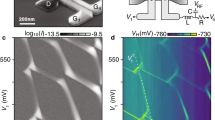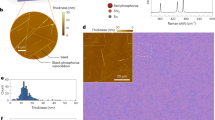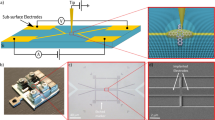Abstract
As the size of semiconductor devices continues to shrink, the normally random distribution of the individual dopant atoms within the semiconductor becomes a critical factor in determining device performance—homogeneity can no longer be assumed1,2,3,4,5. Here we report the fabrication of semiconductor devices in which both the number and position of the dopant atoms are precisely controlled. To achieve this, we make use of a recently developed single-ion implantation technique6,7,8,9, which enables us to implant dopant ions one-by-one into a fine semiconductor region until the desired number is reached. Electrical measurements of the resulting transistors reveal that device-to-device fluctuations in the threshold voltage (Vth; the turn-on voltage of the device) are less for those structures with ordered dopant arrays than for those with conventional random doping. We also find that the devices with ordered dopant arrays exhibit a shift in Vth, relative to the undoped semiconductor, that is twice that for a random dopant distribution (- 0.4 V versus -0.2 V); we attribute this to the uniformity of electrostatic potential in the conducting channel region due to the ordered distribution of dopant atoms. Our results therefore serve to highlight the improvements in device performance that can be achieved through atomic-scale control of the doping process. Furthermore, ordered dopant arrays of this type may enhance the prospects for realizing silicon-based solid-state quantum computers10.
This is a preview of subscription content, access via your institution
Access options
Subscribe to this journal
Receive 51 print issues and online access
$199.00 per year
only $3.90 per issue
Buy this article
- Purchase on Springer Link
- Instant access to full article PDF
Prices may be subject to local taxes which are calculated during checkout




Similar content being viewed by others
References
Keyes, R. W. The effect of randomness in the distribution of impurity atoms on FET thresholds. Appl. Phys. 8, 251–259 (1975)
Mizuno, T., Okamura, J. & Toriumi, A. Experimental–study of threshold voltage fluctuation due to statistical variation of channel dopant number in MOSFET. IEEE Trans. Electron Devices 41, 2216–2221 (1994)
Wong, H. S. & Taur, Y. Discrete dopant distribution effects in nanometer-scale MOSFETs. Microelectron. Reliab. 38, 1447–1456 (1998)
Sano, N. & Tomizawa, M. Random dopant model for three-dimensional drift-diffusion simulations in metal-oxide-semiconductor field-effect-transistors. Appl. Phys. Lett. 79, 2267–2269 (2001)
Ebert, Ph., Jager, N. D., Urban, K. & Weber, E. R. Nanoscale fluctuations in the distribution of dopant atoms: Dopant-induced dots and roughness of electronic interfaces. J. Vac. Sci. Technol. B 22, 2018–2025 (2004)
Ohdomari, I. in Proc. 1st Int. Symp. Control of Semiconductor Interfaces (eds Ohdomari, I., Oshima, M. & Hiraki, A.) 223–240 (North-Holland, Amsterdam, 1994)
Matsukawa, T. et al. Development of single-ion implantation—Controllability of implanted ion number. Appl. Surf. Sci. 117/118, 677–683 (1997)
Shinada, T., Ishikawa, A., Hinoshita, C., Koh, M. & Ohdomari, I. Reduction of fluctuation in semiconductor conductivity by one-by-one ion implantation of dopant atoms. Jpn J. Appl. Phys. 39, L265–L268 (2000)
Shinada, T., Koyama, H., Hinoshita, C., Imamura, K. & Ohdomari, I. Improvement of focused ion-beam optics in single-ion implantation for higher aiming precision of one-by-one doping of impurity atoms into nano-scale semiconductor devices. Jpn. J. Appl. Phys. 41, L287–L290 (2002)
Kane, B. E. A silicon-based nuclear spin quantum computer. Nature 393, 133–137 (1998)
Sze, S. M. Physics of Semiconductor Devices: Physics and Technology 2nd edn (Wiley, New York, 2001)
Acknowledgements
This work was partly supported by the Special Coordination Funds for Promoting Science and Technology, Center of Excellence (COE) research programme and the 21st-century Center of Excellence (21COE) programme from the Ministry of Education, Culture, Sports, Science and Technology, Japan. We thank Y. Shinoda for his critical reading of the manuscript. Author Contributions The experiment was planned by T.S. Samples were prepared, and their electrical properties measured, by T.S., S.O. and T.K. SII was invented by I.O.
Author information
Authors and Affiliations
Corresponding author
Ethics declarations
Competing interests
Reprints and permissions information is available at npg.nature.com/reprintsandpermissions. The authors declare no competing financial interests.
Rights and permissions
About this article
Cite this article
Shinada, T., Okamoto, S., Kobayashi, T. et al. Enhancing semiconductor device performance using ordered dopant arrays. Nature 437, 1128–1131 (2005). https://doi.org/10.1038/nature04086
Received:
Accepted:
Issue Date:
DOI: https://doi.org/10.1038/nature04086
This article is cited by
-
Nanoscale doping of polymeric semiconductors with confined electrochemical ion implantation
Nature Nanotechnology (2024)
-
Energy spectrum and interlevel transitions within the conduction band of a \( D_2^+ \) complex confined in a spherical quantum dot
Optical and Quantum Electronics (2022)
-
Improving the device performances of two-dimensional semiconducting transition metal dichalcogenides: Three strategies
Frontiers of Physics (2022)
-
Terahertz detection with an antenna-coupled highly-doped silicon quantum dot
Scientific Reports (2019)
-
Bandgap prediction by deep learning in configurationally hybridized graphene and boron nitride
npj Computational Materials (2019)
Comments
By submitting a comment you agree to abide by our Terms and Community Guidelines. If you find something abusive or that does not comply with our terms or guidelines please flag it as inappropriate.



